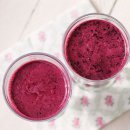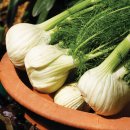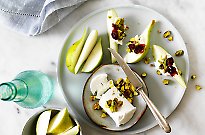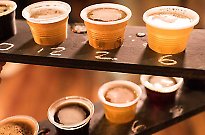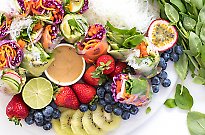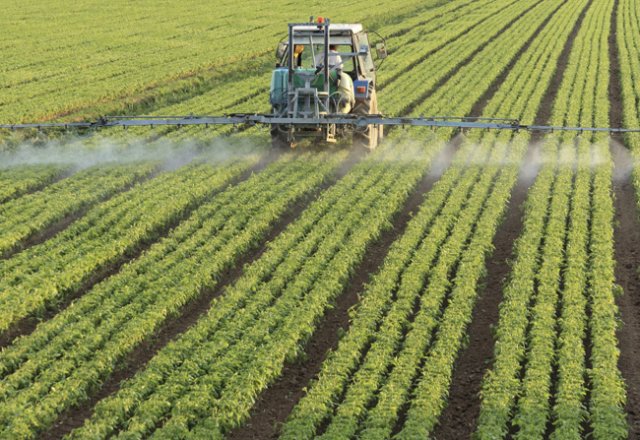
Farming for the future
Farming for the future

If the words ‘organic’ or ‘biodynamic’ make you want to roll your eyes and scream ‘fad’– hold your tongue. There’s a misconception that organics is a new foodie trend or something reserved for left-wing greenies or the well-to-do, but in actual fact, organic and biodynamic farming are the traditional ways of agriculture, nourishing humans and the earth for centuries before conventional farming methods came about.
In fact, conventional farming became the new norm for industrialised countries only after the post-war ‘green revolution’ of the 1950s and ’60s. This period saw the development of new seed varieties and mass use of synthetic fertiliser and irrigation to produce higher yields.
While conventional farming methods, agrichemicals and irrigated water have allowed us to boost food production considerably, they have done so to the detriment of soil and water health and resource depletion, not to mention the impact on animal and human health. Eating organic and biodynamic food promotes healthier and more sustainable farming systems and resource use.
Conventional,
organic and biodynamic farming
The big difference between organic and conventional farming is that conventional farming relies on chemical inputs and an often highly mechanised approach, whereas organics is about farming the natural way – a way of growing food that builds rather than destroys ecosystems. Conventional, organic and biodynamic farming (an advanced version of organics) differ in how they treat soil, plants and animals – the latter recognising the important interactions between the three and working towards creating a healthy, self-sustaining harmony. How different farming methods treat soil, plants and animals defines how sustainable that farming method is.
Soil
Healthy soil is key to sustaining life; after all, without healthy soil we can’t grow food. While many people think of soil as dead matter, it is actually alive with microorganisms that play a vital role in providing the nutrients for plants to grow.
Conventional farming uses fossil-fuel-derived agrochemicals such as fertilisers, insecticides, fungicides and pesticides to add nutrients to the soil or destroy microorganisms in order to control or prevent disease. As controversial as this may sound, many of these chemicals came out of the war; for example, organophosphates, a group of insecticides, were first developed as nerve agents (think sarin gas) for chemical warfare in Germany during the 1930s, then as the more potent VX nerve gas by the British. They were further developed into insecticides by American companies after World War II.
The problem with widespread use of these agrichemicals is that they disrupt the balance of nutrients in the soil by destroying important microorganisms as well as troublesome ones. The capacity for the soil to provide food for plants is destroyed. While farmers can continue applying synthetic fertilisers to boost production for a while, this process is not sustainable – eventually soil condition becomes so poor that no amount of fertiliser can bring it back to life.
Surrounding waterways can also be harmed by the use of agrichemicals, as rain and irrigation leads to runoff. A local example of this is the Great Barrier Reef, where studies have found that runoff from fertilisers used at nearby farms is adding nitrogen and phosphorous into the oceanic ecosystem, causing massive algae growth that leads to depletion in oxygen available for other creatures and decreases the biodiversity in those affected areas.
Organic and biodynamic farming differ by banning the use of synthetic agrichemicals. Instead, these farming methods boost plant growth and control disease through a mixture of companion planting, crop rotation, use of cover crops, natural pest control, hand weeding and animal grazing. These methods nourish the soil and build (rather than take away) its capacity to provide nutrients to plants well into the future. Biodynamic farming goes a step further than organics, using manures and composts like in organics but also introducing herbal and mineral compost additives in order to improve soil structure and enhance biological activity and nutrient cycles essential for plant growth.
Seeds
Conventional farming may include the use of genetically modified (GM) seeds. GM seeds have had their genetic makeup changed to create foods with certain desirable characteristics, such as pesticideresistance or vegetables that take longer to go brown. The use of GM seeds is a contentious issue because not only are we toying with nature, but the health and environmental impacts are as yet unknown and difficult (if not impossible) to monitor and predict. Some potential issues include:
- Insect-resistant crops are formulated to produce a toxin that kills pest insects (such as BT crops). These crops may kill other non-target organisms, which may have a destabilising impact on the local ecosystem.
- Herbicide-tolerant crops are produced so that when sprayed, all other weeds are killed other than the crop (like Monsanto’s Round-Up Ready® soybeans). This promotes the use of more chemicals in farming.
- Farmers using patented GM seeds are not permitted to save their seed and if they are caught doing this they may be sued by the manufacturer. This approach ensures regular annual income for the agribusiness, as farmers must purchase new seed each season.
- Organic and biodynamic farming do not allow GM seeds and require seeds to be organically grown. Organic and biodynamic farmers will often save seeds from previous crops and use rare and heirloom seed varieties, preserving the biodiversity of our food.
Animals
Conventional animal farming allows the use of antibiotics and hormones, residues of which end up being consumed by humans. Conventional farming also allows factory farming (intensive farming) and practices that compromise animal welfare. Over 500 million animals are factory farmed each year in Australia alone, the majority being chickens and pigs, so it’s not a small issue.
Organic and biodynamic animal farming uses organic feed for the animals and does not allow the use of antibiotics or hormones. Organic certification also includes strict animal welfare regulations.
Health benefits of organic or biodynamic food
Over 8,000 chemical pesticide and animal products are registered for use in farming, livestock, horticulture, forestry, homes and so on in Australia. About 300 are registered for use on fruit and vegetables alone. While Australia’s agrichemical and food standard regulation bodies (APVMA and FSANZ) assure us that the level of chemicals found in our food supply is within the safe range, the question is how ‘safe’ these levels really are. Many experts are concerned that even small traces of chemicals in the food we eat build up in our bodies over time or contribute to our ‘toxic load’, the amount of chemicals already in our bodies due to pollutants in air, soil, water, personal care items, household cleaning items, food packaging and more. Results of studies into the effects of low-level exposure to agrichemicals vary from one study to the next and many people agree the jury is still out.
As for nutrients, a 2007 Newcastle University (UK) study reported that organic produce contained up to 40 per cent higher levels of some nutrients (including vitamin C, zinc and iron). Additionally, a 2003 study in the Journal of Agricultural and Food Chemistry found that organic berries and corn boasted 58 per cent more polyphenols – antioxidants that help prevent cardiovascular disease – and up to 52 per cent higher levels of vitamin C than those conventionally grown. Fresh organic and biodynamic food also tastes better, much like the way food tastes when it is home grown.
Why should I pay more for organic and biodynamic food?
There’s no denying that organic and biodynamic food can cost more. There are a number of reasons for the higher price tag, the major two being that food produced in an ecological way requires more manual labour and our economic system doesn’t factor in the true environmental and health costs of conventional farming; this cost is seen down the line and paid through our taxes. At the end of the day, spending a bit more on organic or biodynamic food is about placing greater importance and priority on your own health, that of the plant and the livelihood of smaller family farms (many organic and biodynamic producers are small-scale and family-owned). After all, studies on household expenditure show that Australians spend only 17 per cent of their income on food and almost 40 per cent on discretionary items such as alcohol, clothing, personal care and tobacco. For many Australians, the argument that they can’t afford to purchase organic food is more about the value they place on food in comparison to other lifestyle activities.
When shopping at farmers’ markets you can often purchase seasonal fruit and vegetables at a comparative price; however, speciality items such as meat and cheese often see your food bill rising. A way to combat this is to adopt a nose-to-tail philosophy and explore less popular and cheaper cuts of meat, which can be just as delicious.
Not all organic food is ‘good’ food
It pays to mention that not all food labelled organic, certified or otherwise is ‘good’ food. As the well-known food journalist and author Michael Pollan puts it in his book In Defense of Food: An Eater’s Manifesto:
“Organic Oreos are not a health food. When Coca-Cola begins selling organic Coke, as it surely will, the company will have struck a blow for the environment perhaps, but not for our health. Most consumers automatically assume that the word ‘organic’ is synonymous with health, but it makes no difference to your insulin metabolism if the high-fructose corn syrup in your soda is organic.”
Try sticking to organic or biodynamic unrefined wholefoods like fruits, vegetables, nuts, wholegrain cereals, legumes and sustainable meat and fish to ensure you’re getting the most out of the labels and doing the best for your body as well as the environment.
For more information on conventional, organic and biodynamic farming methods and to download handy resources to help you shop and eat better, visit Sustainable Table’s website at sustainabletable.org.au.
NEXT: Sustainable seafood>>


